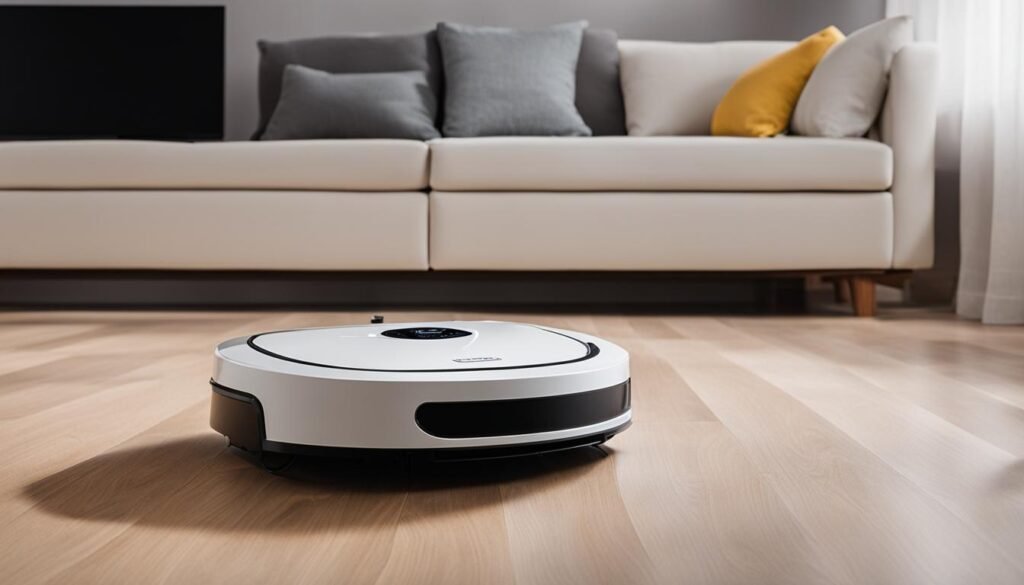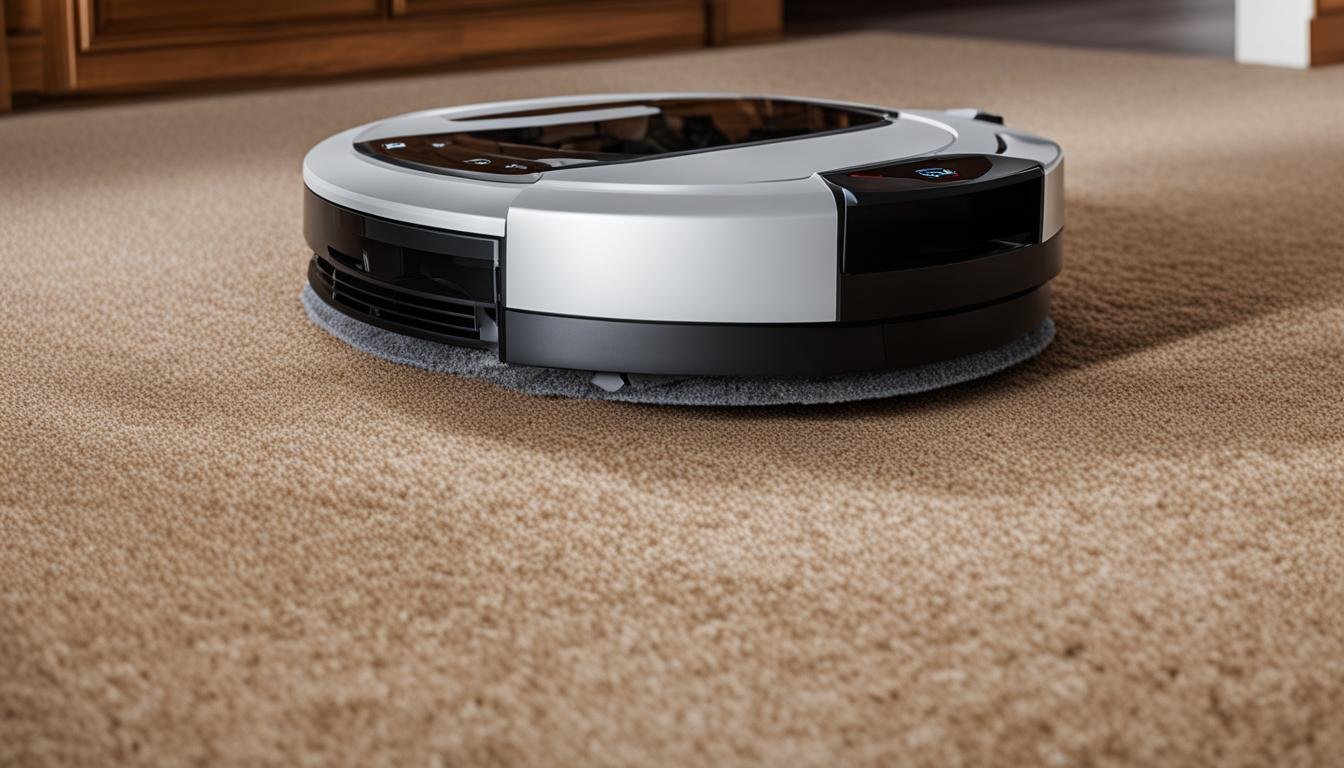When it comes to testing a robot vacuum cleaner, evaluating its performance and efficiency is crucial. Whether you’ve just purchased a new vacuum or want to assess the capabilities of your existing one, understanding the best testing methods is important. By following these tips, you can effectively analyze the performance of your robot vacuum cleaner and ensure optimal cleaning efficiency in your home.
Key Takeaways:
- Properly evaluating a robot vacuum cleaner involves testing various factors including setup and app experience, navigation and cleaning performance, and design and battery life.
- When assessing setup and app experience, consider ease of programming and control, space requirements for the charging station, and connectivity options like Bluetooth or Wi-Fi.
- Testing navigation and cleaning performance entails observing how the vacuum traverses different floor types, avoids obstacles, and navigates back to its base station.
- Evaluating design and battery life involves considering factors like the vacuum’s size and shape, and ensuring the battery can adequately power its cleaning efforts.
- By conducting thorough testing, you can make an informed decision about the efficiency and effectiveness of your robot vacuum cleaner.
Evaluating Setup and App Experience
When testing a robot vacuum cleaner, one of the crucial aspects to evaluate is the setup and app experience. This includes assessing how user-friendly and intuitive the setup process is, as well as examining the functionalities provided by the companion app.
During the setup process, it’s important to consider if the robot vacuum cleaner provides clear instructions and guidance. An easy setup ensures that users can quickly get their vacuum up and running without any hassle or confusion.
One key feature to assess is the scheduling function. A reliable scheduling feature allows users to set specific cleaning times according to their preferences and lifestyle. This enables the robot vacuum cleaner to automatically start cleaning at the designated times, without the need for manual intervention.
Another important aspect to consider is the availability of virtual boundaries in the app. Virtual boundaries are digital boundaries that allow users to restrict or identify specific areas where the robot vacuum cleaner should or should not clean. This feature can be particularly useful for preventing the robot from entering sensitive areas or rooms with delicate belongings.
Additionally, the app experience should include the option to schedule different cleaning modes for specific areas. This allows users to customize the cleaning process based on the needs of different rooms or areas in their home. For example, users can opt for a more thorough cleaning mode in high-traffic areas, while choosing a lighter mode for less frequented spaces.
“The app design and reliability of the connection are also factors to consider, especially for scheduling, virtual boundaries, and area cleaning.”
Testing Navigation and Cleaning Performance

When it comes to evaluating the navigation and cleaning performance of a robot vacuum cleaner, there are several key factors to consider. These factors include how well the vacuum can navigate different floor types, its ability to maneuver around furniture, and its capability to avoid obstacles. Understanding these aspects is crucial in determining the efficiency and effectiveness of the robot vacuum cleaner.
One important aspect of testing navigation is observing how the vacuum traverses various floor types. This includes assessing its ability to transition seamlessly between hardwood floors, carpets, and tiles. The robot vacuum cleaner should be able to adapt its cleaning technique accordingly, ensuring thorough cleaning performance on all types of surfaces.
Additionally, evaluating the vacuum’s ability to maneuver around furniture is essential. The vacuum should be capable of navigating through tight spaces and around obstacles, such as coffee tables, chairs, and cabinets. This ensures that it can reach all areas of your home and provide comprehensive cleaning coverage.
- Scattering objects on the floor is a useful test for assessing the vacuum’s obstacle avoidance capabilities. This test involves placing small items, such as toys or cables, in the vacuum’s path and observing how it navigates around them. A reliable robot vacuum cleaner should have advanced sensors that detect and avoid such obstacles, allowing for uninterrupted cleaning performance.
Another critical aspect to consider is the cleaning pattern employed by the robot vacuum cleaner. Some models clean in a random pattern, while others follow a more methodical approach. A vacuum that cleans in a methodical pattern tends to be more efficient and thorough in covering the entire area. Testing the cleaning pattern can be done by observing the vacuum’s movement and noting whether it follows a logical path or appears to clean haphazardly.
It’s also crucial to ensure that the robot vacuum cleaner successfully navigates back to its base station. This feature is essential as it ensures the vacuum can recharge when needed, without requiring manual intervention. Additionally, the vacuum should be able to effectively clean all areas, including corners, edges, and high-traffic areas of your home, leaving no space untouched.
By thoroughly testing the navigation and cleaning performance of a robot vacuum cleaner, you can determine its ability to adapt to different floor types, avoid obstacles, and provide efficient and comprehensive cleaning. This evaluation process will help you select a vacuum that meets your specific cleaning needs and enhances the cleanliness of your home.
Evaluating Design and Battery Life
When assessing the overall performance of a robot vacuum cleaner, it is crucial to consider its design and battery life. These factors play a significant role in determining the cleaning efficiency and effectiveness of the device.
The size and shape of the robot vacuum cleaner are important considerations. The design should allow the vacuum to reach and clean all areas of your home, including corners and edges that are often missed by conventional vacuum cleaners. By selecting a vacuum with the appropriate size and shape, you can ensure that every nook and cranny is thoroughly cleaned.
In addition to design, battery life is a critical factor to evaluate. A robot vacuum cleaner should have a battery life that is adequate for the size of your home, typically ranging from 60 to 90 minutes. This ensures that the vacuum can complete its cleaning cycle without running out of power and needing to recharge multiple times. A longer battery life allows for uninterrupted cleaning and ensures that the vacuum can cover larger areas efficiently.
By considering the design and battery life of a robot vacuum cleaner, you can select a device that not only meets your cleaning needs but also delivers optimal performance. These factors contribute to the overall cleaning efficiency and effectiveness of the vacuum, ensuring that your home remains spotless with minimal effort.
FAQ
How should I evaluate the setup and app experience of a robot vacuum cleaner?
When evaluating the setup and app experience of a robot vacuum cleaner, you should consider factors such as how easy it is to set up, program, and control the robot. Additionally, assess the space requirements for the charging station and check if the vacuum supports Bluetooth or Wi-Fi connectivity. The design and reliability of the app connection, especially for scheduling, virtual boundaries, and area cleaning, should also be considered.
What should I test when evaluating the navigation and cleaning performance of a robot vacuum cleaner?
To evaluate the navigation and cleaning performance of a robot vacuum cleaner, observe how well it traverses different floor types, maneuvers around furniture, and avoids obstacles. Scatter objects on the floor to assess the vacuum’s obstacle avoidance capabilities. Additionally, observe whether the vacuum cleans in a random or methodical pattern. It’s important to ensure that the vacuum successfully navigates back to its base station and effectively cleans all areas, including corners, edges, and high-traffic areas.
How can I evaluate the design and battery life of a robot vacuum cleaner?
When evaluating the design and battery life of a robot vacuum cleaner, consider factors such as the size and shape of the vacuum. The size and shape may impact its ability to clean certain areas, such as corners and edges. Additionally, check the battery life to ensure it is sufficient for the size of your home, typically ranging from 60 to 90 minutes. Assessing these factors will help you determine whether the robot vacuum cleaner efficiently cleans your home.





Leave a Reply